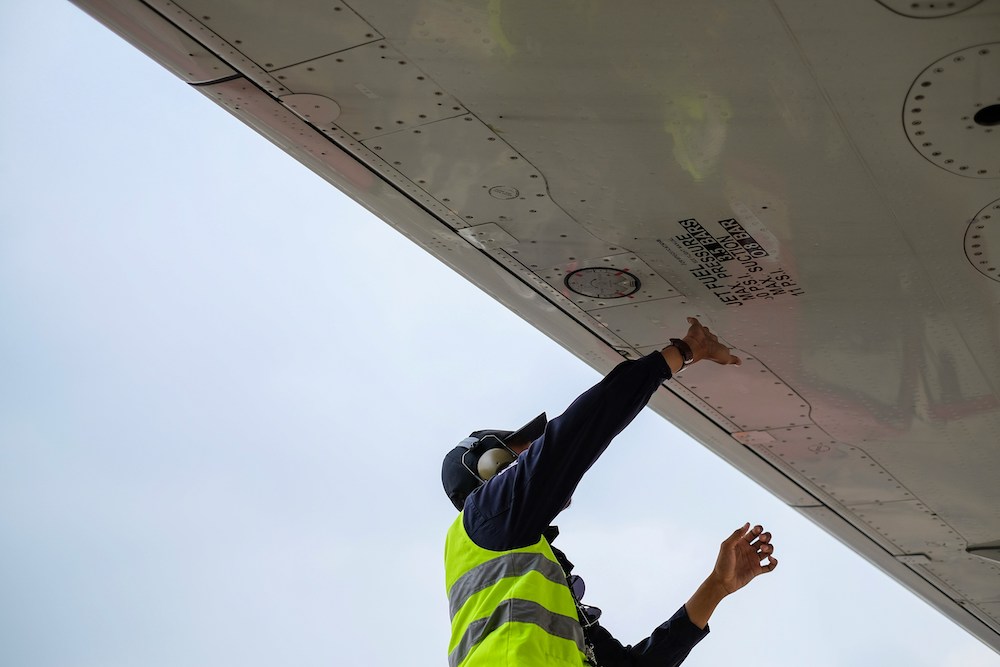
In the dynamic world of aviation and aerospace, inventory management can be a daunting and complicated task. With unpredictable schedules, strict compliance regulations, complex and multi-component inventory stocks/stores, and an ever-changing environment, it is easy to see why efficient inventory management can make or break an aviation company.
The ultimate goal of aviation inventory management is to anticipate supply chain disruptions, better forecast market demand and price fluctuations, and support overall smooth operations. To assist, ePlaneAI highlights common mistakes and practical solutions that enable you to seize control of a constantly in flux aerospace parts inventory.
10 Most Common Aviation Inventory Management Mistakes
Before we discuss the suggestions for how to improve inventory management practices in 2024, let’s first explore some of the most common mistakes made by aerospace companies:
1. Overstocking. Ordering excessive aviation parts inventory can lead to storage issues, increased holding costs, and potential obsolescence. Therefore, companies should regularly review demand patterns and adjust reorder quantities of their inventory accordingly. Tools like ePlaneAI compile data from dozens of third-party resources and syncs with your own ERP, enabling it to provide forward-thinking insights and guidance accessible through Conversational Analytics.
Click here to read about Applying Predictive Analytics to Make Smart Aviation Marketplace Decisions.
2. Understocking. Running out of stock disrupts operations, disappoints customers, and affects revenue. Therefore, companies should implement accurate inventory demand forecasting and safety stock levels.
3. Neglecting inventory accuracy. Inaccurate counts result in discrepancies between records and actual stock. Therefore, companies should conduct regular physical counts, use barcodes, and invest in inventory management software solutions.
4. Poor organization. Chaotic storage leads to inefficiencies, lost items, and delays. Therefore, companies should organize inventory logically, label bins, and maintain the cleanliness of their stores.
5. Ignoring deadstock. Deadstock refers to items that do not sell or become obsolete. Therefore, companies should identify slow-moving items and implement strategies (i.e., discounts, bundling) to clear them from their stores.
6. Lack of rotation. Not following proper rotation techniques (i.e., first in, first out or last in, first out) affects item quality and shelf life. Therefore, companies should train staff on rotation principles and enforce them consistently.
7. Manual processes. Relying solely on manual tracking increases the chances of errors. Therefore, companies should invest in inventory management software for automation and accuracy.
8. Not considering seasonality. Failing to adjust inventory levels based on seasonal demand leads to excess or shortage. Therefore, companies should analyze historical data and plan for seasonal fluctuations accordingly.
9. Ignoring supplier relationships. Poor communication with suppliers affects timely replenishment. Therefore, companies should maintain good relationships, negotiate terms, and collaborate effectively with their suppliers.
10. Neglecting technology updates. Outdated systems hinder efficiency and competitiveness. Therefore, companies should regularly evaluate and upgrade inventory software and hardware.
For additional potential issues that may arise, read Aircraft Parts Inventory Management & 8 Mistakes to Avoid.
4 Critical Inventory Aircraft Parts Management Solutions for 2024
Now, let’s discuss some of the most relevant inventory management solutions for 2024 in more detail, with the focus on:
- Standardization of data formats
- Implementation of robust inventory management systems
- Close collaboration with suppliers
- Focus on documentation, training, and oversight practices
(1) Standardization of Data Formats in Inventory Management
One way to significantly enhance aviation part inventory management and control is through the standardization of inventory data formats using serialization and traceability. Serialization and traceability, in turn, impact aviation/aerospace companies’ safety, operational preparedness, and cost efficiency.
Inventory Serialization
Serialization in aerospace inventory management uses a unique identification number (i.e., serial number) to record critical information about each aviation item in stock. The number shows where a particular item was manufactured, shipped, and used in operations.
Inventory Traceability
An aircraft part inventory management system with item-level traceability allows tracking an individual item’s movement from its origin to the end of its useful life, allowing companies to know exactly where an individual item is at any given time and who is handling it.
Benefits of Data Formats Standardization in Aviation Parts Inventory Management
Inventory serialization and traceability ensure aviation/aerospace companies:
- Use only the correct, authorized, and compliant components in operations, minimizing the risk of equipment failures and safety hazards
- Know the exact history of the components, while maximizing operational preparedness (e.g., scheduling maintenance and potentially leveraging maintenance tracking software)
- Enable its leaders to make informed decisions about resource allocation resulting in cost savings, while maximizing asset utilization
(2) Implementation of Robust Inventory Management Systems
An inventory management system is a piece of software used to track inventory items at an aviation/aerospace company and oversee all the processes involved in stock optimization. Any inventory management system’s bottom-line goal is to ensure the right aviation parts are available, in the right amounts, at the right time, with as few manual tasks involved as possible.
Inventory Management System Considerations
Inventory management systems can vary from one another, therefore, when choosing a part inventory management system, aviation companies should ensure all the features necessary to them are included, such as forecasting, barcode scanning, stock notifications, reports, etc.
When assessing an aircraft part inventory management system, companies should consider timing, integrations, features, ease of use, support, and development. Furthermore, companies should consider embracing advanced technologies, such as blockchain, the Internet of Things, and artificial intelligence (AI) to simplify and enhance data visibility, accuracy, and security throughout their operations.
Benefits of Inventory Management Systems
Any company selling and/or storing aircraft or aerospace parts must track inventory in one way or another and using an automated, computerized system has many benefits, including:
- Less time wasted on manual tasks
- More consistent operational delivery
- Stock levels are updated in real time
- Reduced labor costs
- More insightful analytics and reports
- Faster fulfillment from improved organization
- Less cash wasted on unnecessary inventory and storage
(3) Close Collaboration with Suppliers in Inventory Management
Suppliers are an essential part of an aviation/aerospace company’s inventory management process. Collaborating with suppliers ensures a steady supply of materials at the right time and cost while avoiding stockouts. Sharing inventory data and projections with suppliers, implementing vendor-managed inventory systems, negotiating inventory agreements, and developing contingency plans can optimize aircraft inventory management processes for any company.
Inventory Data and Projection Sharing
Sharing data with suppliers can help them understand the company’s inventory needs and plan accordingly. This transparency promotes trust between the aviation/aerospace companies and their suppliers.
Vendor-Managed Inventory (VMI) System Implementation
A VMI system allows suppliers to monitor the company’s inventory levels and automatically replenish stock when necessary. This strategy reduces the risk of stockouts, improves lead times, and eliminates manual ordering processes.
Inventory Agreement Negotiation
Negotiating with suppliers for flexible supply contracts can help the company manage costs more effectively. These contracts can include minimum order quantities, lead times, and pricing terms that benefit both parties.
Contingency Plan Development
Unforeseen events, such as natural disasters or supplier disruptions, can significantly impact inventory management processes. Having a contingency plan in place can help aviation/aerospace companies mitigate risks and minimize inventory disruptions.
(4) Focus on Documentation, Training, and Oversight Practices in Inventory Management
When aviation companies standardize their inventory data formats, implement robust inventory management systems, and collaborate closely with suppliers, they must develop proper standard operating procedures, train their employees in these procedures, and provide oversight to ensure everything is working as designed.
Creating Standard Operating Procedures (SOPs)
SOPs are documented processes created by companies to ensure consistency throughout their operations. They establish guidelines and instructions, so employees know what to do in specific situations, allowing them to be productive while complying with regulations and company expectations. SOPs are crucial because they:
- Increase productivity by reducing errors. Incorrectly performed tasks cause delays and frustration. SOPs help prevent mistakes, ensuring efficiency, quality output, and uniformity. When everyone follows the same procedures, miscommunication and non-compliance with industry regulations decrease.
- Reduce training time. Whether onboarding new hires or training existing employees for new responsibilities, clear instruction is essential. SOPs make the education experience consistent, ensuring all employees learn how to perform tasks correctly. Existing team members can focus on their work, and trainees can refer to SOPs when needed, reducing waiting time for answers or feedback from supervisors.
Developing Comprehensive Training Plans
Every aviation company should develop a comprehensive training plan covering all aspects of its inventory management system, including:
- Inventory control procedures, such as receiving, storing, and tracking inventory.
- Product knowledge, such as understanding features, benefits, and shelf life.
- Customer service, such as handling inquiries related to inventory.
- Safety protocols, such as the proper handling and storing of inventory.
- Problem-solving skills, such as addressing inventory-related challenges.
Combining different training approaches can further ensure a positive learning experience:
- Classroom training can be used for training sessions with presentations.
- On-the-job training can be used for practical experience while performing inventory tasks.
- Online training can be used for self-paced learning.
- Scenario-based training can be used to simulate real-world scenarios.
All in all, a well-trained team contributes to efficient inventory management, cost savings, and overall business success.
Providing Ongoing Oversight
As inventory management evolves, aviation companies must pay particular attention to change management. Aerospace organizations should provide regular updates to their employees on new procedures, software, and best practices. They should also monitor employee progress by assessing their understanding of procedures and performance and addressing any gaps through additional training or coaching. Finally, companies should provide feedback and recognition to their employees by acknowledging employees’ efforts and improvements and recognizing their achievements related to inventory accuracy and efficiency.
Aircraft and Aerospace Inventory Management Optimization in a Nutshell
Knowing what a company has and where it has it is a critical aspect of operations. In aircraft and aerospace inventory management, this is especially important when it comes to mission assurance. By standardizing data formats, implementing robust inventory management systems, collaborating closely with suppliers, and focusing on documentation, training, and oversight practices, aviation and aerospace companies can significantly improve their profitability in 2024.
By Katarzyna Szwed-Carlson
Kasia Szwed-Carlson is an expert in the aviation industry with 15 years of experience working in flight operations management and training leadership roles.



